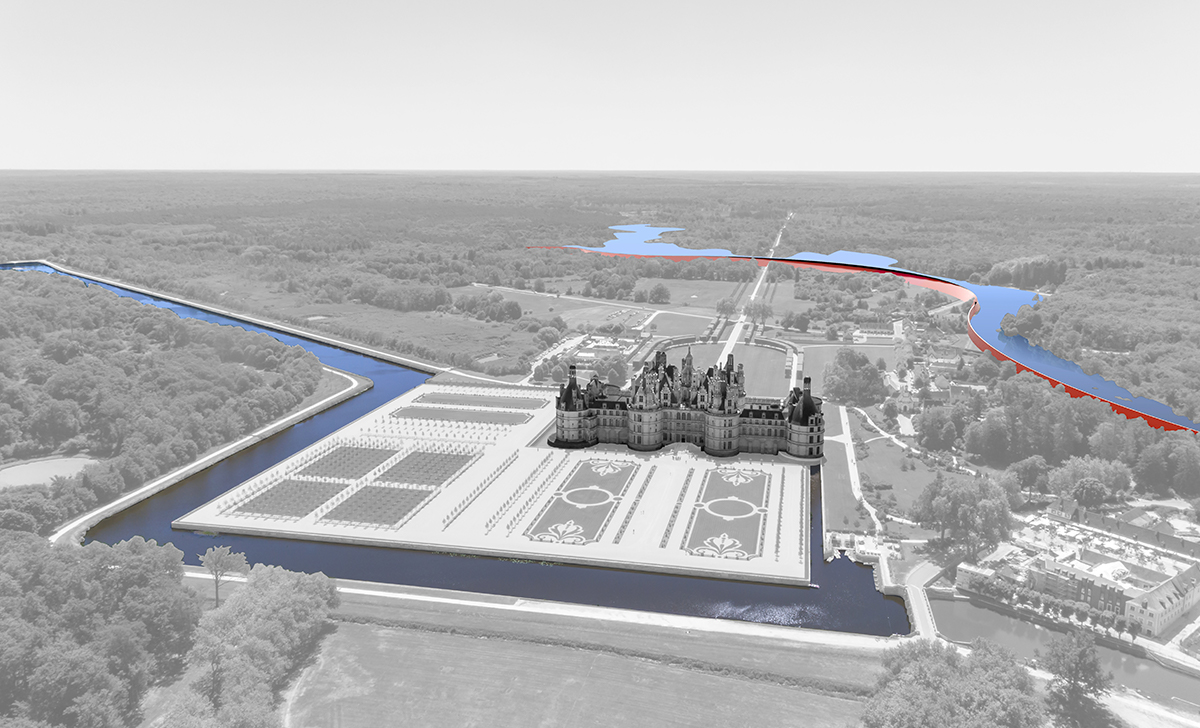2018-2019 COTE Top Ten Winners
Winner: Après le Déluge
Will Letchinger & Jonathan Wilkinson
Juror Comments
With an overarching goal of addressing resiliency at a historic preservation site, Après le Déluge is an elegant solution to a multivalence of problems. This project combines an unusual mixture of programs with a need for elevating infrastructure and does so in a way where each initiative is supported by the other. Although this project could seek further development, it is a beautiful solution to a complex issue.
Project Description
Château de Chambord is drowning: a victim to the forces of climate change. Our proposal takes flooding to an extreme–one in which cultural heritage is at risk of being lost. Regional analysis and sections of the site’s topography reveal a point of intervention for holding and diverting water away from the marshy land at the base of the Château. Our project, a low-dam that diverts water downstream of the Château, is built to resist the rising water. A large ribbon is defined by two twisting surfaces that slip above and below one another, taking advantage of the prevalent wind and sun while a public path weaves between the surfaces. From the Château, a thin line cuts across the horizon; reflective glass abstracting the domain beyond.
The focus of our project is a strategy for water retention, protecting Château de Chambord from flooding while maintaining the existing ecosystem. Across the nearly 3 kilometers of the project a variety of conditions exist. Nearly 1.8 km of the project on the West side is a simple concrete retaining wall. To the East, the wall thickens to create an occupiable section. While the two surfaces define an enclosure nearly 19,000 m2, only 12,500 m2(135,000 ft2) is fully enclosed. The program of the building has a purposeful dual nature: a social rehabilitation facility matched with an ecology research. Residents work alongside researchers to conduct ecological research with direct access for field experiments. Sensitive laboratory programs are woven with medical and therapeutic facilities; residential room and amenities, dining and relaxation areas; storage and administrative zones. Access to both the lake and the forest is crucial for both healing and research.
The project is located in Chambord, an UNESCO World Heritage Site in the Loire Valley of Central France. The Château was constructed in 1519 and sits in a 13,000-acre protected site, entirely enclosed by a wall for much of the last 500 years. This region is a Subpolar Oceanic Climate, with average temperature ranges of 3.2°C (37°F) in January to 19°C (66°F) in July. Yearly rainfall comes to 25-30” overall, often focused in intense storms late in Autumn. The Cosson River bisects the domain North/South and has been modified to align with the Château (construction of the castle required that its marshy site be drained). This poses a risk to the castle during the rainy season. In 2016, the site experienced an unprecedented flood that threatened the castle. Much of the site is heavily forested and interspersed with ponds, lakes and tributaries. Winds come from the South-Southwest much of the year.

 Study Architecture
Study Architecture  ProPEL
ProPEL 



















